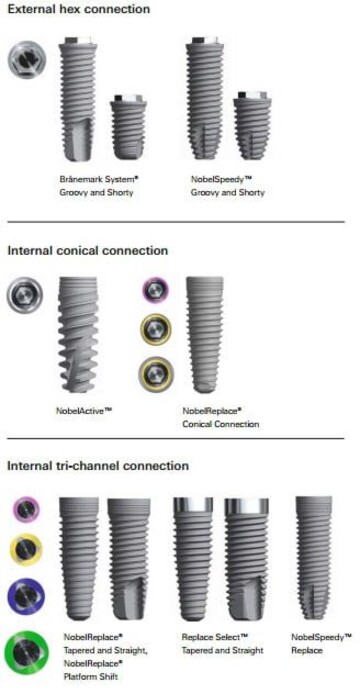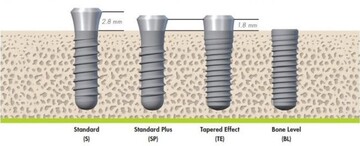Implants
An implant is a titanium "root" which can be placed into the jawbone. Once integrated with your bone, the implant can be used to support a crown, a bridge, or secure a complete denture. Dental implants may be used to eliminate partial plates and dentures. Implants have been used successfully for over thirty years, have a high success rate and function and feel like your natural teeth. Dental implants are now the standard of care for replacing missing teeth. Dental implant treatment represents a slightly greater investment than conventional treatment; however, the benefits of implant therapy for most patients outweigh the minor additional cost involved.
In order to place an implant, a couple of steps must be taken:
1) An incision is made into the gums using very precise measurements, then using a very small drill, the jawbone is given a "tap" that will allow the implant to be placed. After the implant is screwed into place, the gums are closed up and the healing process begins. This process can take approximately three to six months to ensure the implant has fused with the bone and created a sturdy base for the new teeth.
2) When the implant is ready, an abutment is attached to the implant, which allows for a new crown to be placed or a denture to be attached.
On the day of your appointment please arrive 15-20 minutes prior to your scheduled time. This has proven to help patients settle in and release the pre-surgery nervousness. We will make you as comfortable as possible during your visit.
We recommend bringing along a friend or relative on the day of your treatment. Depending on the procedure itself, you may be receiving anesthesia and possibly other medication during the surgery. It is important that an adult accompany you to the office, stay during the procedure and drive you home after your recovery.
We will provide you with detailed information regarding medication, food, drink, and other preparations that you may need. Please follow their instructions on the day of your treatment. We will also provide you with complete post-surgery instructions including cleaning and maintenance instructions, and if necessary we'll provide you with prescriptions for any medications necessary to reduce the post-surgery discomfort and to help you toward a speedy recovery.
We'll arrange follow-up appointments to assure you maintain a beautiful, natural smile for years to come.
Do not disturb the wound. Avoid rinsing, spitting, or touching the wound on the day of surgery. There will be a metal healing abutment protruding through the gingival (gum) tissue.
BLEEDING. Some bleeding or redness in the saliva is normal for 24 hours. Excessive bleeding can be controlled by biting on a gauze pad placed directly on the bleeding area for 30 minutes. If bleeding continues please call the office for further instructions.
SWELLING. Swelling around the mouth, cheeks, eyes and sides of the face is not uncommon as it is the body’s normal process in repairing itself. Swelling does not always appear immediately. It may take 12 to 24 hours before swelling becomes apparent. Swelling may not reach its maximum until 2-3 days post-surgery. Swelling may be minimized by the immediate use of ice packs post-surgery. Two baggies filled with ice, or ice packs should be applied to the sides of the face where surgery was performed. The ice packs should be left on continuously while you are awake. After 36 hours, ice has no beneficial effect. If swelling or jaw stiffness has persisted for several days call the office.
DIET. Drink plenty of fluids. Avoid hot liquids or hot food. Soft food and liquids should be eaten on the day of surgery. Return to a normal diet as soon as possible unless otherwise directed.
PAIN MEDICATION. You should begin taking pain medication as soon as you feel the local anesthetic wearing off. For moderate pain, 1 or 2 Tylenol or Extra Strength Tylenol may be taken every 3-4 hours. Ibuprofen (Advil or Motrin) may be taken instead of Tylenol. Ibuprofen, bought over the counter comes in 200 mg tablets: 2-3 tablets may be taken every 3-4 hours as needed for pain. For severe pain, the prescribed medication should be taken as directed. Be sure to take the prescribed antibiotics as directed to help prevent infection. Do not take any of the above medication if you are allergic, or have been instructed by Denver Dental Specialties, PLLC not to take it.
HOME HYGIENE CARE. The night of surgery, use the prescribed Peridex Oral Rinse before bed. The day after surgery, the Peridex should be used twice daily, after breakfast and before bed. Be sure to rinse for at least 30 seconds then spit it out. Warm salt water rinses (teaspoon of salt in a cup of warm water) should be used at least 4-5 times a day, as well, especially after meals. Brushing your teeth and the healing abutments is no problem, but be gentle initially with brushing the surgical areas. Good oral hygiene is essential to good healing.
PHYSICAL ACTIVITY. Keep physical activities to a minimum immediately following surgery. Physical activity could cause throbbing or bleeding of the surgical implant area.
WEARING DENTURES. You will always have teeth during your recovery period. Temporary partial dentures or full denture arches should not be used immediately after surgery and for at least 10 days.
Do you have missing teeth? It is critically important to replace missing teeth. Eating and chewing with missing teeth can sabotage your bite and lead to incessant discomfort. Missing teeth can give rise to a mouth rearrangement that often results in facial changes that look decrepit. If a tooth is missing or has been extracted for any reason, a single implant can be used to replace the missing tooth. The implant is placed into the bone of the jaw and acts as the new tooth root. After the bone has healed over the implant an abutment can be placed on the implant and a crown can then be attached. This method of tooth replacement looks and feels like natural teeth.
In cases where multiple teeth are missing or have been extracted, multiple implants can be used to bring back your smile. The implants are placed into the jawbone and are given time to heal. After the bone has healed around the implants, an abutment is attached to the implant which then allows for a crown or bridge to be placed right on the implant. These new teeth will look and act just like natural teeth.
Ask Dr. Brown or Dr. Kardelas, popular implant dentists in Lakewood, if dental implants are right for you.
In many situations it is possible to remove the diseased and/or loose teeth and replace them with dental implants at the same time. In almost all situations simultaneous bone grafting is completed. This method of treatment reduces the number of surgical visits. It also speeds up the entire process enabling the implants to be ready to receive (caps/crowns) more quickly.
Before making the decision in going the implant route, ask yourself if there is another option. We offer many different implant alternatives.
The different alternative options to implants that we provide are:
- Tooth Supported Bridge
- Removable Partial Denture
- No Treatment
An MDI mini implant is an implant used to provide better denture stability in patients that cannot handle standard implant surgery, do not have enough bone to support a standard implant or are going from one prosthetic system to another due to continuing therapy.
The top of an MDI implant is shaped like a ball that allows a rubber o-ring to snap in over the ball when the denture is placed onto it. These types of implants can usually be placed in one or two office visits because there is no waiting on the jawbone to heal. In most situations the patient can walk out with their dentures the same day they receive their implants.
For more than twenty years, Nobel Biocare dental implants have been produced from chemically unchanged variants of commercially pure titanium. They are cold-worked for exceptional strength and durability, and all feature TiUnite, our proprietary surface that produces benefits in implant stability and bone formation.
The decision to replace missing teeth with dental implants is an excellent investment in your oral health and appearance. Dental implants are now the standard of care for missing teeth. Better than crown and bridge, they look, feel and function like natural teeth. They help prevent bone loss caused by a missing tooth root and do not require the adjacent teeth to be ground down.
Long-term research has shown that Straumann implants have a high success rate. Straumann values quality and reliability, and Straumann implants are backed by over 30 years of scientific evidence.
Buser D et al. 10-year survival and success rates of 511 titanium implants with a sandblasted and acid-etched surface: a retrospective study in 303 partially edentulous patients. Clin Implant Dent Relat Res. 2012 Dec;14(6):839-51.







